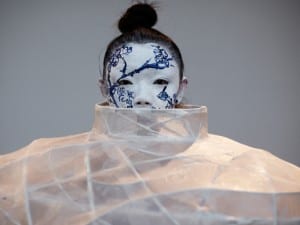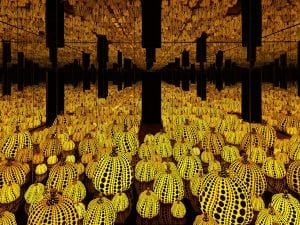Artist Donna Mclean is interested in polarity and paradox – light / dark; beauty / unease; seduction / aversion. Her paintings avoid being decorative or easy on the eye by choosing difficult imagery imbued with an aesthetic that simultaneously comforts and disturbs. For Atomic, a series of oil paintings depicting atomic bombs, Mclean watched hours of archive film. She renders humankind’s capacity to inflict both destruction and suffering on each other, alongside its ability to create something astonishing. Here, we speak to the artist about her shortlisted work, now on display at the Aesthetica Art Prize Exhibition 2024.
A: Atomic addresses an unsettling topic – these are paintings that feel both manageable in their scale, but uncomfortable in their focus. Could you talk about the use of paradox in your work?
DM: I have no desire to paint a large or even medium sized atom bomb. The miniature scale is the point – to take something huge and threatening and reduce it to something small, exquisite – gem-like. My subject matter is varied: paradox and polarity are the things that tie the work together. I have a fear of being purely decorative but I want my paintings to have aesthetic beauty. I think the uneasy subject matter helps me to do this. The beauty is intended to come from the handling of the paint and trying to get as much luminosity into the work as I can. I am firmly rooted in the tradition of figurative painting which is something that could be viewed as old fashioned. I don’t want to resort to gimmickry but I don’t want the work to feel hackneyed and dated. I think these small acts of rebellion help to keep the work unorthodox and fresh.
A: Which archive films did you watch in order to compose the paintings?
DM: Most of the reference material came from nuclear archive footage on YouTube. I preferred to take the images from filmed footage rather than photography. It gave me more control in decision making. I also edited a lot while painting – removing information I felt to be superfluous or irrelevant like foliage or too much background. I wanted the bombs to be small but iconic and centre-stage. I took creative liberties with some of them and changed things to make it work formally within the whole piece.
A: Which of the pieces from Atomic were your favourite to paint? Which ones stand out?
DM: My favourite bombs to paint were the surprising ones that don’t usually get reproduced. There are some that felt anthropomorphic – reminding me of flowers, icebergs, olive trees, spaceships and sunsets. I was less interested in the classic mushroom we’ve all come to associate with the atomic bomb. The fact that it’s such an extraordinary shape-shifter is one of the many qualities that make it so compelling. Since completing Atomic and a companion piece called Boom, I’ve made some stand alone small paintings of explosions. They are generally of the bombs that remind me of other things.
A: How do you conceptualise beauty and aestheticism in your practice?
DM: I like my beauty (and I’m speaking in the most general way here – not just in painting) to have some element that knocks it off a little. I want some grit alongside the pearl. I think if something is just undiluted pleasantness and easy on the eye it can almost cancel itself out. I think beauty needs an unaesthetic underbelly of some kind to be truly interesting. It also feels slightly transgressive and exciting to be quickened by something thats not the usual template of what beauty is supposed to be.

A: Which artists inspire you?
DM: My favourite artists: Balthus, Bruegel, Cormac McCarthy, David Lynch, Philip Larkin, Vija Celmins, Tarkovsky.
A: What does it mean to be shortlisted for the Aesthetica Art Prize 2024?
DM: I think that getting shortlisted for any prize is a great affirmation. Painting is a very solitary profession and it’s hard to keep faith with one’s owns ideas sometimes. I’m looking forward to meeting all the other artists in York and seeing the exhibition in its entirety.
Mclean features in the Aesthetica Art Prize 2024 Exhibition at York Art Gallery from 16 February – 21 April. Plus, meet over 250 longlisted international artists in our new online gallery.
Want to get involved? The next edition of the Prize is open for entries. Submit your work by 31 August. Win £10,000, exhibition and publication. Find out more here.
All images courtesy of Donna Mclean.





